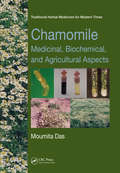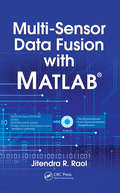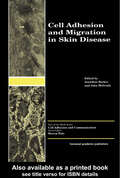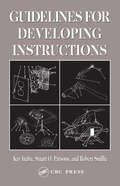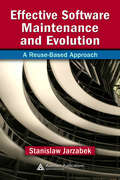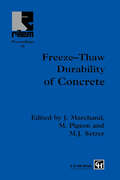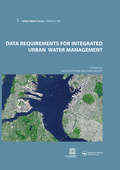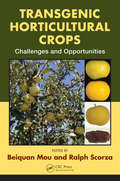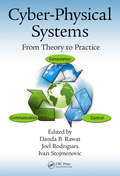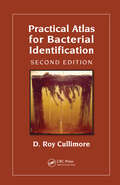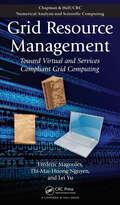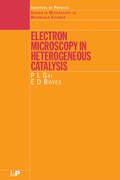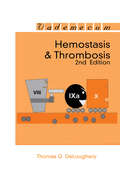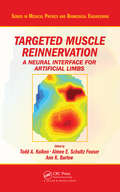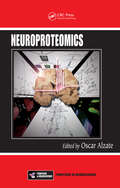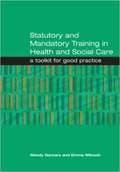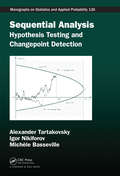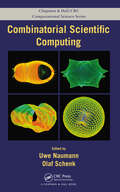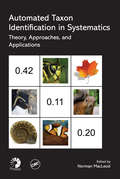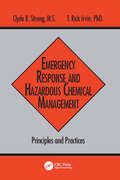- Table View
- List View
Environmental Risk Analysis: Probability Distribution Calculations
by Louis TheodoreA Training Tool for the Environmental Risk ProfessionalEnvironmental Risk Analysis: Probability Distribution Calculations defines the role that probability distributions play in risk analysis, and gives direction on how to measure and compare the magnitude of risk more efficiently. Designed for the practicing environmental engineer and scientist, t
Chamomile: Medicinal, Biochemical, and Agricultural Aspects (Traditional Herbal Medicines for Modern Times)
by Moumita DasIn use as a medicinal plant since time immemorial in Europe and the Middle East, chamomile is gaining popularity in the Americas, Australia, and Asia. The spectrum of disease conditions in which it is used in traditional medicine systems is, quite simply, mind boggling. There is, without a doubt, a growing demand for this plant and therefore a grow
Multi-Sensor Data Fusion with MATLAB
by Jitendra R. RaolUsing MATLAB examples wherever possible, Multi-Sensor Data Fusion with MATLAB explores the three levels of multi-sensor data fusion (MSDF): kinematic-level fusion, including the theory of DF; fuzzy logic and decision fusion; and pixel- and feature-level image fusion. The authors elucidate DF strategies, algorithms, and performance evaluation mainly
Cell Adhesion and Migration in Skin Disease
by Jonathan Barker John McGrathThe past few years have seen considerable advances in our understanding of the molecular basis underlying cutaneous cell adhesion mechanisms. Co-authored by a number of leading experts in the field ^Cell Adhesion and Migration in Skin Disease provides a comprehensive overview of the critical role played by cell adhesion in determining the structure
Wireless Networks and Mobile Computing
by Koushik Sinha Sasthi C. Ghosh Bhabani P. SinhaWireless communication is one of the fastest growing industry segments today. Many types of wireless networks are now being used for applications such as personal communication, entertainment, rural and urban healthcare, smart home building, inventory control, and surveillance. This book introduces the basic concepts of wireless networks and mobile
Guidelines for Developing Instructions
by Kay Inaba Stuart O. Parsons Robert J. SmillieConfusing, inadequate instructions for setting up and using consumer products are not only unhelpful, but potentially dangerous. They may contain wrong information, poor warnings, and no pictures or illustrations. Standards are either non-existent or little known, even though the U.S. government has developed and tested standards for the past thirt
Effective Software Maintenance and Evolution: A Reuse-Based Approach
by Stanislaw JarzabekWith software maintenance costs averaging 50% of total computing costs, it is necessary to have an effective maintenance program in place. Aging legacy systems, for example, pose an especially rough challenge as veteran programmers retire and their successors are left to figure out how the systems operate. This book explores program analyzers, reve
Freeze-Thaw Durability of Concrete
by J. Marchand M. Pigeon M. SetzerConcrete durability in climates where freezing and thawing occurs is a continuing problem. It is particularly acute for highway and bridge structures, where de-icing salts are used to combat the effects of frost, snow and ice. These salts can cause damage to concrete and accelerate corrosion of reinforcements. This book presents the latest internat
Data Requirements for Integrated Urban Water Management: Urban Water Series - UNESCO-IHP (Urban Water Series)
by Tim D. Fletcher and Ana DeletiicIntegrated urban water management relies on data allowing us to analyse, understand and predict the behaviour of the individual water cycle components and their interactions. The concomitant monitoring of the complex of urban water system elements makes it possible to grasp the entirety of relations among the various components of the urban water c
Transgenic Horticultural Crops: Challenges and Opportunities
by Beiquan Mou Ralph ScorzaAs the world debates the risks and benefits of plant biotechnology, the proportion of the global area of transgenic field crops has increased every year, and the safety and value continues to be demonstrated. Yet, despite the success of transgenic field crops, the commercialization of transgenic horticultural crops (vegetables, fruits, nuts, and or
Cyber-Physical Systems: From Theory to Practice
by Danda B. Rawat Joel J.P.C. Rodrigues Ivan StojmenovicAlthough comprehensive knowledge of cyber-physical systems (CPS) is becoming a must for researchers, practitioners, system designers, policy makers, system managers, and administrators, there has been a need for a comprehensive and up-to-date source of research and information on cyber-physical systems. This book fills that need.Cyber-Physical Syst
Practical Atlas for Bacterial Identification
by D. Roy CullimorePublished nearly ten years ago, the first edition of Practical Atlas for Bacterial Identification broke new ground with the wealth of detail and breadth of information it provided. The second edition is poised to do the same. Differing fundamentally from the first edition, this book begins by introducing the concept of bacteria community intelligen
TERRA- 1: The Role of Earth Observations from Space
by Paul M. MatherThis text aims to offer information on research approaches to assessing global environment changes. It includes suggestions for the exchange of ideas between those studying land surface and remote sensing specialists, and advocates synthesizing the findings of different disciplines.
Grid Resource Management: Toward Virtual and Services Compliant Grid Computing (Chapman & Hall/CRC Numerical Analysis and Scientific Computing Series)
by Frederic Magoules Thi-Mai-Huong Nguyen Lei YuGrid technology offers the potential for providing secure access to remote services, thereby promoting scientific collaborations in an unprecedented scale. Grid Resource Management: Toward Virtual and Services Compliant Grid Computing presents a comprehensive account of the architectural issues of grid technology, such as security, data management,
Electron Microscopy in Heterogeneous Catalysis (Series in Microscopy in Materials Science)
by P.L Gai E.D BoyesCatalysis is one of the most important technologies in the industrial world, controlling more than 90% of industrial chemical processes and essential for large-scale production of plastics and fuel. Exploring the most common type of catalysis used in industry, Electron Microscopy in Heterogeneous Catalysis provides a coherent account of heterogeneo
Building Acoustics
by Tor Erik VigranBuilding or architectural acoustics is taken in this book to cover all aspects of sound and vibration in buildings. The book covers room acoustics but the main emphasis is on sound insulation and sound absorption and the basic aspects of noise and vibration problems connected to service equipment and external sources. Covering all aspects of sound and vibration in buildings, this book explores room acoustics, sound insulation, and noise and vibration problems connected to service equipment and external sources.
Hemostasis and Thrombosis
by Thomas G. DeLougheryThis book offers a practical guide to recognizing, diagnosing, and managing patients with common and uncommon hemostatic and thrombotic disorders. It also presents up-to-date information on the novel antithrombotic agents introduced on the market. The book is intended for healthcare providers.
Targeted Muscle Reinnervation: A Neural Interface for Artificial Limbs (Series in Medical Physics and Biomedical Engineering)
by Todd A. Kuiken Aimee E. Schultz Feuser Ann K. BarlowImplement TMR with Your Patients and Improve Their Quality of LifeDeveloped by Dr. Todd A. Kuiken and Dr. Gregory A. Dumanian, targeted muscle reinnervation (TMR) is a new approach to accessing motor control signals from peripheral nerves after amputation and providing sensory feedback to prosthesis users. This practical approach has many advantage
Textbook of Pleural Diseases
by Richard W. Light Y.C. Gary LeeThe Second Edition of this book was the Winner of the First Prize (Respiratory Category) at the British Medical Association Medical Book Awards. Textbook of Pleural Diseases is a comprehensive reference that covers both the basic and clinical science on pleural diseases. Building on the highly respected previous editions, it includes a detailed bas
Neuroproteomics
by Oscar AlzateIn this, the post-genomic age, our knowledge of biological systems continues to expand and progress. As the research becomes more focused, so too does the data. Genomic research progresses to proteomics and brings us to a deeper understanding of the behavior and function of protein clusters. And now proteomics gives way to neuroproteomics as we beg
Statutory and Mandatory Training in Health and Social Care: A Toolkit for Good Practice
by Wendy Garcarz Emma WilcockStatutory and mandatory training is an area that all healthcare organisations are required to tackle, yet it is commonly undertaken as a tick-box exercise without flair or creativity. Proof of attendance at a training course is not in itself proof of competence. This practical reference has been designed to support health and social care organisations wanting to create a structured approach to statutory and mandatory training, to review existing training or just to make improvements to ensure legal compliance and safe working practices. It provides logical, step-by-step guidance to reassure managers and trainers that they are meeting their legal responsibilities and therefore minimising the risk of litigation. It also offers frameworks and templates for assessing and recording competence and identifying further training needs. Statutory and Mandatory Training in Health and Social Care will be useful to everyone involved in training with responsibilities at strategic and operational level, and particularly to chief executives, directors and senior managers, human resources staff, safety officers, clinical governance managers, cross-infection nurses, community and school nurses, and managers of GP surgeries, care homes, residential nursing homes, day centres, and nurseries.
Sequential Analysis: Hypothesis Testing and Changepoint Detection (Chapman & Hall/CRC Monographs on Statistics and Applied Probability)
by Alexander Tartakovsky Igor Nikiforov Michele BassevilleSequential Analysis: Hypothesis Testing and Changepoint Detection systematically develops the theory of sequential hypothesis testing and quickest changepoint detection. It also describes important applications in which theoretical results can be used efficiently. The book reviews recent accomplishments in hypothesis testing and changepoint detecti
Combinatorial Scientific Computing
by Uwe Naumann Olaf SchenkCombinatorial Scientific Computing explores the latest research on creating algorithms and software tools to solve key combinatorial problems on large-scale high-performance computing architectures. It includes contributions from international researchers who are pioneers in designing software and applications for high-performance computing systems
Automated Taxon Identification in Systematics: Theory, Approaches and Applications
by Norman MacLeodThe automated identification of biological objects or groups has been a dream among taxonomists and systematists for centuries. However, progress in designing and implementing practical systems for fully automated taxon identification has been frustratingly slow. Regardless, the dream has never died. Recent developments in computer architectures an
Emergency Response and Hazardous Chemical Management: Principles and Practices
by Clyde B. Strong T. Rick IrvinManagement of hazardous chemicals and materials-particularly during emergency release situations-is a critical part of routine training required for workers and professionals in the chemical, petroleum and manufacturing industries. Proper storage of highly reactive chemical agents, correct choice of protective clothing and safety issues in confined

